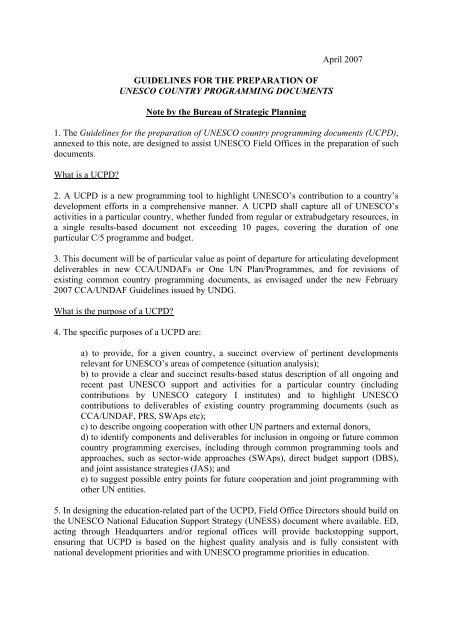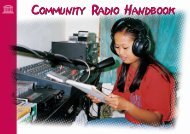Guidelines for the preparation of UNESCO country programming
Guidelines for the preparation of UNESCO country programming
Guidelines for the preparation of UNESCO country programming
Create successful ePaper yourself
Turn your PDF publications into a flip-book with our unique Google optimized e-Paper software.
GUIDELINES FOR THE PREPARATION OF<br />
<strong>UNESCO</strong> COUNTRY PROGRAMMING DOCUMENTS<br />
Note by <strong>the</strong> Bureau <strong>of</strong> Strategic Planning<br />
April 2007<br />
1. The <strong>Guidelines</strong> <strong>for</strong> <strong>the</strong> <strong>preparation</strong> <strong>of</strong> <strong>UNESCO</strong> <strong>country</strong> <strong>programming</strong> documents (UCPD),<br />
annexed to this note, are designed to assist <strong>UNESCO</strong> Field Offices in <strong>the</strong> <strong>preparation</strong> <strong>of</strong> such<br />
documents.<br />
What is a UCPD?<br />
2. A UCPD is a new <strong>programming</strong> tool to highlight <strong>UNESCO</strong>’s contribution to a <strong>country</strong>’s<br />
development ef<strong>for</strong>ts in a comprehensive manner. A UCPD shall capture all <strong>of</strong> <strong>UNESCO</strong>’s<br />
activities in a particular <strong>country</strong>, whe<strong>the</strong>r funded from regular or extrabudgetary resources, in<br />
a single results-based document not exceeding 10 pages, covering <strong>the</strong> duration <strong>of</strong> one<br />
particular C/5 programme and budget.<br />
3. This document will be <strong>of</strong> particular value as point <strong>of</strong> departure <strong>for</strong> articulating development<br />
deliverables in new CCA/UNDAFs or One UN Plan/Programmes, and <strong>for</strong> revisions <strong>of</strong><br />
existing common <strong>country</strong> <strong>programming</strong> documents, as envisaged under <strong>the</strong> new February<br />
2007 CCA/UNDAF <strong>Guidelines</strong> issued by UNDG.<br />
What is <strong>the</strong> purpose <strong>of</strong> a UCPD?<br />
4. The specific purposes <strong>of</strong> a UCPD are:<br />
a) to provide, <strong>for</strong> a given <strong>country</strong>, a succinct overview <strong>of</strong> pertinent developments<br />
relevant <strong>for</strong> <strong>UNESCO</strong>’s areas <strong>of</strong> competence (situation analysis);<br />
b) to provide a clear and succinct results-based status description <strong>of</strong> all ongoing and<br />
recent past <strong>UNESCO</strong> support and activities <strong>for</strong> a particular <strong>country</strong> (including<br />
contributions by <strong>UNESCO</strong> category I institutes) and to highlight <strong>UNESCO</strong><br />
contributions to deliverables <strong>of</strong> existing <strong>country</strong> <strong>programming</strong> documents (such as<br />
CCA/UNDAF, PRS, SWAps etc);<br />
c) to describe ongoing cooperation with o<strong>the</strong>r UN partners and external donors,<br />
d) to identify components and deliverables <strong>for</strong> inclusion in ongoing or future common<br />
<strong>country</strong> <strong>programming</strong> exercises, including through common <strong>programming</strong> tools and<br />
approaches, such as sector-wide approaches (SWAps), direct budget support (DBS),<br />
and joint assistance strategies (JAS); and<br />
e) to suggest possible entry points <strong>for</strong> future cooperation and joint <strong>programming</strong> with<br />
o<strong>the</strong>r UN entities.<br />
5. In designing <strong>the</strong> education-related part <strong>of</strong> <strong>the</strong> UCPD, Field Office Directors should build on<br />
<strong>the</strong> <strong>UNESCO</strong> National Education Support Strategy (UNESS) document where available. ED,<br />
acting through Headquarters and/or regional <strong>of</strong>fices will provide backstopping support,<br />
ensuring that UCPD is based on <strong>the</strong> highest quality analysis and is fully consistent with<br />
national development priorities and with <strong>UNESCO</strong> programme priorities in education.
UCPD - promoting coherence, intersectorality and visibility<br />
6. A UCPD should also focus on promoting coherence among <strong>UNESCO</strong> sectoral inputs and<br />
those <strong>of</strong> o<strong>the</strong>r partners and on fostering intersectoral and interdisciplinary engagement. UCPD<br />
shall also provide a basis <strong>for</strong> a results-based, strategic approach to <strong>the</strong> mobilization <strong>of</strong> extrabudgetary<br />
funds.<br />
7. A UCPD shall lead to an enhanced visibility <strong>of</strong> <strong>UNESCO</strong> in terms <strong>of</strong> its contributions to<br />
national development.<br />
8. Field Offices should feel free to adapt, as necessary, <strong>the</strong> proposed <strong>for</strong>mat to <strong>the</strong> specific<br />
circumstances <strong>of</strong> a <strong>country</strong> concerned while retaining as far as possible <strong>the</strong> main components<br />
and chapter headings. By using a comparable <strong>for</strong>mat, with linkages also to common <strong>country</strong><br />
programme documents, <strong>the</strong> UCPD will allow <strong>UNESCO</strong> to develop a harmonized presentation<br />
<strong>of</strong> <strong>country</strong> <strong>programming</strong> experiences across all regions.<br />
9. It is not envisaged that <strong>the</strong> UCPD will be <strong>for</strong>mally signed, although a Memorandum <strong>of</strong><br />
Understanding could be concluded in general terms between <strong>UNESCO</strong> and <strong>the</strong> appropriate<br />
national counterparts, if <strong>the</strong>y so desire.<br />
ANNEX<br />
The UCPD shall consist <strong>of</strong> <strong>the</strong> following sections:<br />
PART I - SITUATION ANALYSIS<br />
This section in<strong>for</strong>ms and prepares <strong>the</strong> ground <strong>for</strong> <strong>the</strong> identification <strong>of</strong> entry points <strong>for</strong> future<br />
action by providing an overview <strong>of</strong> pertinent development in <strong>the</strong> <strong>country</strong> in regards to:<br />
a) Existing <strong>country</strong> assessments: A summary <strong>of</strong> available <strong>country</strong> assessments (CCA or<br />
similar documents providing an assessment <strong>of</strong> national capacities, etc.) in <strong>the</strong> fields <strong>of</strong><br />
competence <strong>of</strong> <strong>UNESCO</strong>, ideally with hyperlinks to <strong>the</strong> relevant documents;<br />
b) Pertinent development issues: An overview <strong>of</strong> trends towards achieving all<br />
internationally agreed development goals relevant <strong>for</strong> <strong>UNESCO</strong>’s fields <strong>of</strong> competence ,<br />
including <strong>the</strong> Millennium Development Goals (MDGs), and <strong>the</strong> objectives <strong>of</strong> <strong>the</strong> 2005<br />
World Summit Outcome document as well as <strong>the</strong> situation relating to <strong>the</strong> implementation<br />
<strong>of</strong> targets set by international conferences and conventions relevant to <strong>UNESCO</strong>.<br />
c) Challenges and opportunities: The nature <strong>of</strong> challenges facing <strong>UNESCO</strong> taking into<br />
consideration:<br />
a) national development priorities;<br />
b) expectations addressed to <strong>UNESCO</strong> in its fields <strong>of</strong> competence;<br />
c) <strong>the</strong> contribution <strong>of</strong> o<strong>the</strong>r development partners in <strong>the</strong>se domains;<br />
d) opportunities <strong>for</strong> extrabudgetary resource mobilization.<br />
PART II - PAST AND PRESENT COOPERATION - LESSONS LEARNED<br />
This core section provides an overview <strong>of</strong> approaches and key results achieved as well as a<br />
succinct description <strong>of</strong> lessons learned, taking stock <strong>of</strong> <strong>the</strong> status quo. The section contains:
a) Description <strong>of</strong> principal <strong>UNESCO</strong> activities: A description <strong>of</strong> <strong>the</strong> principal areas <strong>of</strong><br />
<strong>UNESCO</strong> support and activities in <strong>the</strong> <strong>country</strong> during <strong>the</strong> current and <strong>the</strong> past one or two<br />
biennia.<br />
b) Resources: available regular and extrabudgetary resources.<br />
c) Key results achieved: A description <strong>of</strong> expected key results to be achieved in <strong>the</strong> <strong>country</strong><br />
through ongoing <strong>UNESCO</strong> interventions and those realised during <strong>the</strong> past one or two<br />
biennia, with reference to conclusions <strong>of</strong> recent reviews and evaluations, if any. This<br />
should also include consideration <strong>of</strong> cross-cutting issues like gender equality or youth.<br />
d) Lessons learned: A succinct description <strong>of</strong> major lessons learned – what worked (good<br />
practice), and what did not work - including a short reference as to how such lessons will<br />
be taken into account in future <strong>programming</strong>.<br />
PART III - PROPOSED COOPERATION FRAMEWORK<br />
Building on <strong>the</strong> preceding sections, this section describes key areas and priorities <strong>for</strong> future<br />
action and related expected results.<br />
All expected results <strong>for</strong> future activities should be summarized in a UCPD results matrix. This<br />
matrix shall show separately expected results/deliverables pertaining to activities included in<br />
an existing UNDAF/ One Plan, and those <strong>of</strong> activities not integrated in an UNDAF/ One Plan.<br />
The <strong>for</strong>mulation <strong>of</strong> results and <strong>the</strong>ir presentation should follow <strong>UNESCO</strong>’s results chain,<br />
distinguishing between expected results, per<strong>for</strong>mance indicators and benchmark/targets and<br />
<strong>the</strong>ir relation to <strong>the</strong> <strong>UNESCO</strong> Action/MLA concerned.<br />
The proposed cooperation framework should summarise activities <strong>for</strong> which funds are likely<br />
to be provided from <strong>the</strong> Regular Programme, Governmental sources and extra-budgetary<br />
resources, which are already in hand and <strong>for</strong> which a signed donor agreement or ano<strong>the</strong>r<br />
commitment exists. It should <strong>the</strong>n delineate areas where <strong>the</strong> programme could be rein<strong>for</strong>ced<br />
or expanded with funds yet to be mobilized.<br />
PART IV - PARTNERSHIPS<br />
This section <strong>of</strong> <strong>the</strong> UCPD shall set out <strong>the</strong> strategy and approaches <strong>for</strong> engaging with o<strong>the</strong>r<br />
development partners and outline <strong>the</strong>ir respective roles/contributions.<br />
Partnerships with UN system agencies, donors, private sector or civil society organizations<br />
and o<strong>the</strong>r development partners are to be based on agreed joint priorities in fur<strong>the</strong>rance <strong>of</strong><br />
national priorities.
UCPD results matrix (outcomes/ results included in <strong>the</strong> UNDAF/ One Plan)<br />
UNDAF/ One Plan expected<br />
outcome/ result<br />
Expected result <strong>of</strong><br />
<strong>UNESCO</strong> activity<br />
Per<strong>for</strong>mance indicators and<br />
benchmarks<br />
Available<br />
resources in US$<br />
Mobilization<br />
target in US$<br />
UCPD results matrix (outcomes/ results not included in <strong>the</strong> UNDAF/ One Plan)<br />
Expected result <strong>of</strong> <strong>UNESCO</strong><br />
activity<br />
Per<strong>for</strong>mance indicators and<br />
benchmarks<br />
Available<br />
resources in US$<br />
Mobilization<br />
target in US$<br />
UNDAF/ One Plan outcome/ result<br />
to which expected result could be<br />
seen as contributing – if any

















